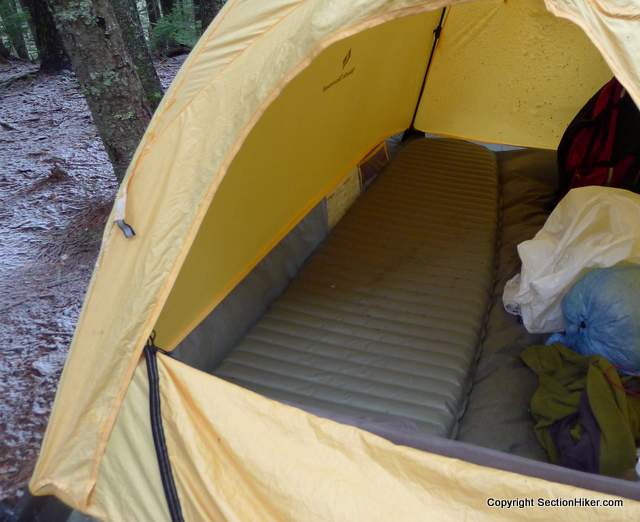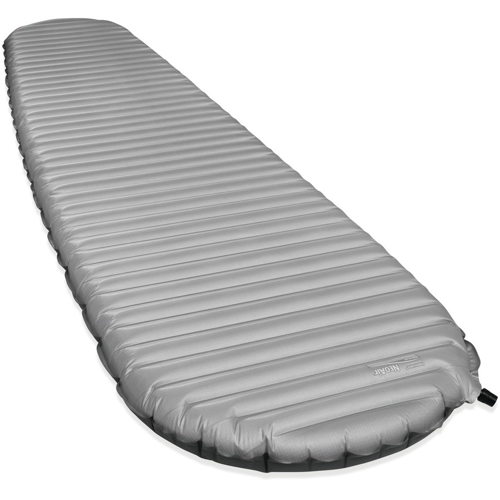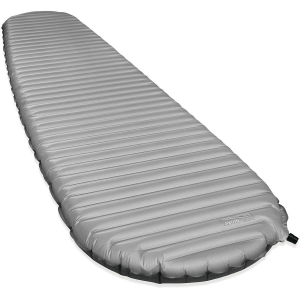
The Therm-a-Rest XTherm Sleeping Pad is an insulated air mattress designed for cold weather camping with an R-value of 5.7. Weighing just 15 oz, it's also exceptionally lightweight, durable, and packs up small, which explains its popularity with winter campers and backpackers. Many people underestimate the importance of their sleeping pad in their overall sleep system. If you find you're still cold with enough insulation topside, your pad is probably insufficient. For winter camping below freezing, I recommend that people use a sleeping pad with an R-value of 5 to 6, to help insure that they get a decent nights sleep. R-values are additive, so you can also stack multiple pads together for more warmth.
Specs at a Glance
- Color: Gray
- R-Value: 5.7
- Size tested: Regular
- Weight: 15 oz / 430 g
- Optional inflation sack: 1.8 oz / 51 g
- Optional stuff sack: 0.6 oz / 17g
- Width: 20 in / 51 cm
- Length: 72 in / 183 cm
- Thickness: 2.5 in / 6.3 cm
- Packed dimension: 9 x 4.0 / 23 x 10
- Top fabric type: 30d High Tenacity Nylon
- Bottom fabric type: 70d Nylon Soft Grip
The Therm-a-Rest NeoAir XTherm is designed to trap your body heat and reflect it back at you when you sleep at night. It achieves this using a honeycombed construction of air baffles that are covered with a reflective metallic coating. The result is a highly compressible and lightweight air mattress that rolls up to the size of a Nalgene bottle, making it very easy to pack. The baffle insulation system used in the NeoAir XTherm is the same across all of the pads in the Therm-a-Rest NeoAir product line, including the NeoAir XLite, which is by far the most popular sleeping pad made today.

The XTherm has horizontal baffles which are comfortable for back and side sleepers and the very reliable stick valve used across Therm-a-Rest's many sleeping pad products. While you can inflate the NeoAir XTherm by blowing into its stick valve, Therm-a-Rest bundles an inflation sack with the XTherm that you can use instead. It has an adapter at one end that fits over the XTherm's valve. To inflate, you open the bag and let air flow into it, before bunching the top closed and pressing hard on the bag's sides. This pushes air into the pad to inflate it. Using the inflation sack is preferable over blowing up the pad in winter because your breath contains moisture that can freeze and interfere with the XTherm's ability to insulate. When fully inflated, the XTherm is firm to sleep on. I prefer a slightly softer pad, so I let a little air out when I use it.
The NeoAir XTherm is a few ounces heavier than the NeoAir XLite because it's made with thicker and more durable fabrics, because you can't afford a leak in cold winter weather. The top is made with a 30 denier high tenacity nylon, while the bottom is make with a 70 denier soft grip nylon. Fabrics with a high denier are thick, sturdy, and durable, while ones with low denier count tend to be sheer, soft, and silky. The current XTherm is less crinkly and quieter sounding than earlier versions, although the sound is also deadened by the thicker fabrics on the pad's exterior.

The XTherm is available in weight-saving mummy shape in two sizes: a regular (72″ x 2o" x 2.5″) or a long (77″ x 2o" x 2.5″). A wide 25″ rectangular version called the NeoAir XTherm Max is also available in a regular (72″ x 25″ x 2.5″) or long size (77″ x 25″ x 2.5″), which is good if your arms fall off the sides of a 20″ mattress.
Outdoor Industry R-Value Standards
If you find that you're sleeping cold when temperatures fall below freezing, check the R-value of your sleeping pad. If it's lower than 5 or 6, I'd recommend getting yourself an XTherm or adding an inexpensive foam pad like the Therm-a-Rest Zlite, which has an R-value of 2.6, underneath your existing sleeping pad. R-values are additive and the best way to measure the insulation value of sleeping pads. The downside of carrying a second foam pad is that it's heavier and bulkier, but it is an inexpensive alternative to buying an XTherm.
If you own a sleeping pad that doesn't have a manufacturer-documented R-value, it will soon. The outdoor industry passed a new R-value sleeping pad standard in late November of 2018, that is expected to roll out to consumers by 2020. REI and MEC, in Canada, have already purchased equipment so they can independently test the sleeping pads they sell, so you might see standardized R-values values even sooner. The new standard defines a common test methodology for determining sleeping pad R-values, so that consumers can compare the R-values of different pads from different manufacturers.

Companies like Big Agnes and NEMO that haven't rated their sleeping pads with R-values, put consumers at a real disadvantage in terms of quantifying their insulation value for several reasons. First, they don't explain whether the temperatures relate to air temperature or ground temperatures. They don't explain how the temperature ranges were determined. There's no way to combine two pads and know what the combined temperature rating will work out to since they're not additive like R-values, and there's no distinction between men and women, given that women sleep about 10 degrees colder than men. I'd go as far as to recommend staying away from winter pads that don't have R-value ratings, until the new R-value standards kick in and all sleeping pad vendors are required to test and publish them.
Comparable Insulated Inflatable Sleeping Pads
| Make / Model | R-Value | Weight (oz) | Dimensions (in) |
|---|---|---|---|
| Therm-a-Rest NeoAir XTherm | 5.7 | 15 | 72 x 20 x 2.5 |
| REI Flash Insulated | 3.7 | 15 | 72 x 20 x 2 |
| REI Stratus Insulated | 2.9 | 21 | 72 x 20 x 2.5 |
| Sea-to-Summit Ultralight Insulated | 3.3 | 16.9 | 72 x 21.5 x 2 |
| Sea-to-Summit Comfort Light Insulated | 4.2 | 21.8 | 72 x 21.5 x 2 |
| Big Agnes Q-Core SLX | Unrated | 16 | 72 x 20 x 4.25 |
| Big Agnes Insulated Air Core Ultra | Unrated | 21 | 72 x 20 x 3.5 |
| Big Agnes Insulated AXL | Unrated | 11.9 | 72 x 20 x 3.75 |
| Exped Downmat 9 XP | 8 | 31.2 | 72 x 20.5 x 3.5 |
| Exped Downmat UL Winter | 7 | 22.2 | 72 x 20 x 3.5 |
| Exped Synmat HL | 5 | 15.2 | 72 x 20 x 3.5 |
| Klymit Insulated V Ultralite SL | 4.4 | 15.2 | 72 x 20 x 2.5 |
| Klymit Insulated V Ultralight SL | 4.4 | 19.5 | 72 x 20 x 2.5 |
| Klymit Insulated Static V | 4.4 | 24 | 72 x 20 x 2.5 |
| NEMO Tensor Insulated | Unrated | 21 | 72 x 20 x 3 |
| NEMO Astro Insulated Lite | Unrated | 19 | 72 x 20 x 3.5 |
| NEMO Vector Insulated | Unrated | 19 | 72 x 20 x 3 |
Recommendation
The Therm-a-Rest NeoAir XTherm Insulated Air Mattress is an inflatable winter sleeping pad with an R-value of 5.7. I've been using one for 5 years and think its the best winter sleeping pad you can own in terms of insulation value, comfort and weight. At a miserly 15 ounces, the XTherm also takes up very little room in a winter backpack, since it doesn't contain bulky down feathers or synthetic insulation. This is an important consideration for winter use where space is at a premium since you need to carry so much more insulation, equipment, food, and fuel.
Highly Recommended!
Disclosure: The author purchased this product.
Compare 5 Prices
-

 Sunny Sports $199.95View
Sunny Sports $199.95View -

 REI.com $199.95View
REI.com $199.95View -
 Moosejaw $199.95View
Moosejaw $199.95View -

 Eastern Mountain Sports $199.95View
Eastern Mountain Sports $199.95View -

 Amazon US $239.95View
Amazon US $239.95View -
 Moosejaw $239.95View
Moosejaw $239.95View
The post Therm-a-Rest NeoAir XTherm Insulated Sleeping Pad Review appeared first on Section Hikers Backpacking Blog.
from Section Hikers Backpacking Blog https://ift.tt/2Lb4Ebw

No comments:
Post a Comment